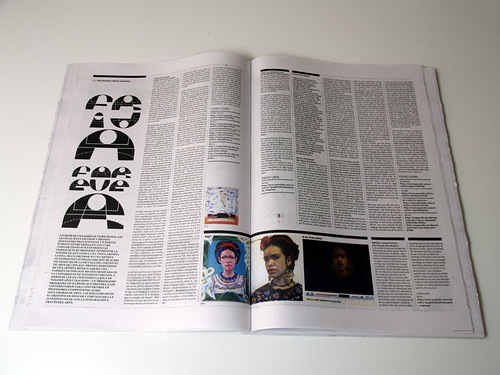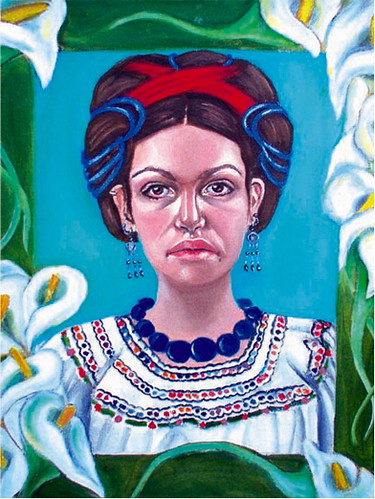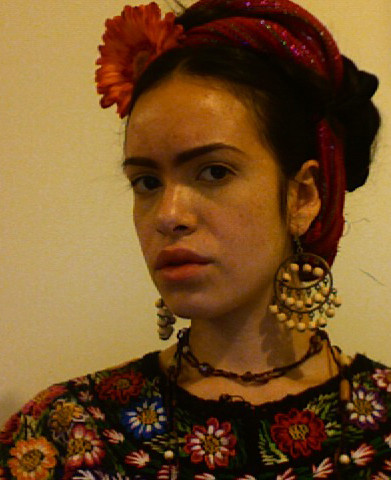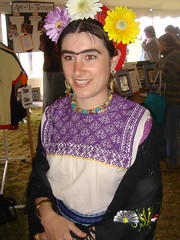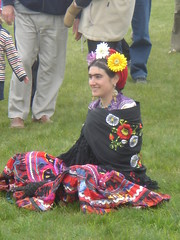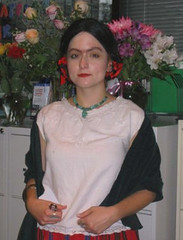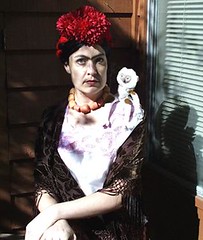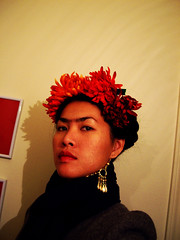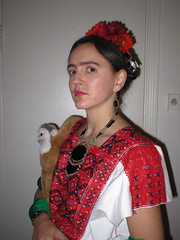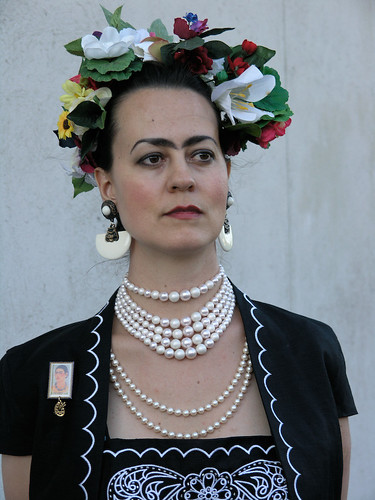[youtube=http://www.youtube.com/watch?v=bGk3-OJX7KE]A recent tumblr find, led me to the remarkable work of Stacyann Chin.
Blurring Boundaries Between Jewish Denominations
Excerpt from the Tzit Tzit: Fiber Art and Jewish Identity Exhibition Catalog, by curator Ben Schacter.
Maya Escobar is a Latina Jew who relishes her ability to blur the boundaries not only between cultures but Jewish denominations. Her Shomer Negiah Panites is an extreme example. The expression shomer negiah refers to the law that limits sexual relations. While a women is menstruating and for several days after, she is not allowed to touch her husband. At the end of this time, she takes a ritual bath called a mikvah. This monthly ritual balances abstinence, cleanliness and intimacy. It is said by those who follow this tradition that time together is made even more precious. Shomer Negiah Panties, 2005Escobar’s work seems to turn this custom on its ear. First, sexuality in the Orthodox community is not publicly displayed. Underwear or anything remotely like it would not be shown in public. Second, part of the function of shomer negiah is one of modesty, not one to tease. But in a twist of modernity, the “tease” can be a way of female control. To exclaim, “Hands Off!” at precisely the moment of greatest vulnerability is exactly what Escobar’s underwear does.Heckshered Tallis presents an air of transgression without doing so. A hecksher is a stamp placed on food to certify that its ingredients and method of processing follows the dietary rules observed by many Jews, called Kashrut. The symbols themselves have nothing to do with prayer and do not belong on a tallis, or prayer shawl, but the obsessive imprimatur suggests an over compensation on the part of the wearer. Women are not required to wear such garments but some congregants of more liberal egalitarian congregations do. Is Escobar suggesting women’s insecurity by obsessively certifying this tallis as “Kosher?”
Shomer Negiah Panties, 2005Escobar’s work seems to turn this custom on its ear. First, sexuality in the Orthodox community is not publicly displayed. Underwear or anything remotely like it would not be shown in public. Second, part of the function of shomer negiah is one of modesty, not one to tease. But in a twist of modernity, the “tease” can be a way of female control. To exclaim, “Hands Off!” at precisely the moment of greatest vulnerability is exactly what Escobar’s underwear does.Heckshered Tallis presents an air of transgression without doing so. A hecksher is a stamp placed on food to certify that its ingredients and method of processing follows the dietary rules observed by many Jews, called Kashrut. The symbols themselves have nothing to do with prayer and do not belong on a tallis, or prayer shawl, but the obsessive imprimatur suggests an over compensation on the part of the wearer. Women are not required to wear such garments but some congregants of more liberal egalitarian congregations do. Is Escobar suggesting women’s insecurity by obsessively certifying this tallis as “Kosher?”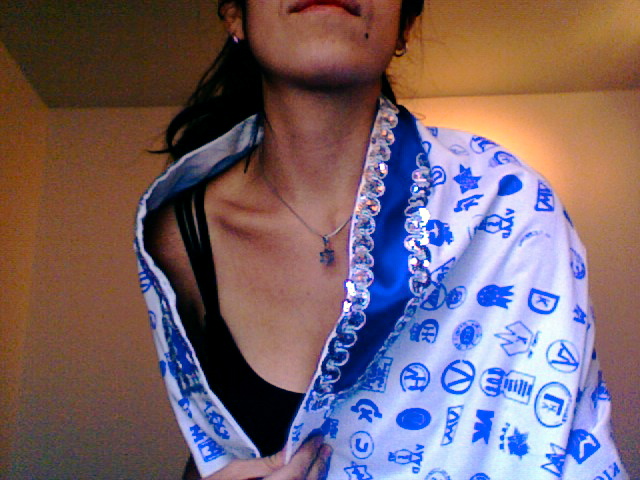 Kosher Davening, 2006The pattern of heckshers also creates a fashion akin to a Louis Vuitton print where the fabric is paradigmatic of luxury. Hechshered Tallis brings high fashion and religion together in a satisfyingly truthful and critical way. Even more interesting is the way Escobar’s work comments on different traditions and laws through fashion. Escobar’s oeuvre highlights denominational fragmentation by drawing attention to certain details of Jewish life. The traditional woman who follows shomer negiah would most likely not wear a tallis. Identity is rarely mixed in this way. For an artist to be able to make cross-denominational commentary such as found in Shomer Negiah Panties and Heckshered Tallis takes keen observation. Escobar does not exempt her own experience from such examination.As she shared with me, her family chided her to make napkins for her future, now husband. This traditional role, that is to make the home, chaffed her mildly. She was resistant to such commonplace assumptions about gender so to exaggerate the request, she embroidered “napkin for my husband” across hand woven fabric. Her actions as a wife would thus never be taken for granted.
Kosher Davening, 2006The pattern of heckshers also creates a fashion akin to a Louis Vuitton print where the fabric is paradigmatic of luxury. Hechshered Tallis brings high fashion and religion together in a satisfyingly truthful and critical way. Even more interesting is the way Escobar’s work comments on different traditions and laws through fashion. Escobar’s oeuvre highlights denominational fragmentation by drawing attention to certain details of Jewish life. The traditional woman who follows shomer negiah would most likely not wear a tallis. Identity is rarely mixed in this way. For an artist to be able to make cross-denominational commentary such as found in Shomer Negiah Panties and Heckshered Tallis takes keen observation. Escobar does not exempt her own experience from such examination.As she shared with me, her family chided her to make napkins for her future, now husband. This traditional role, that is to make the home, chaffed her mildly. She was resistant to such commonplace assumptions about gender so to exaggerate the request, she embroidered “napkin for my husband” across hand woven fabric. Her actions as a wife would thus never be taken for granted.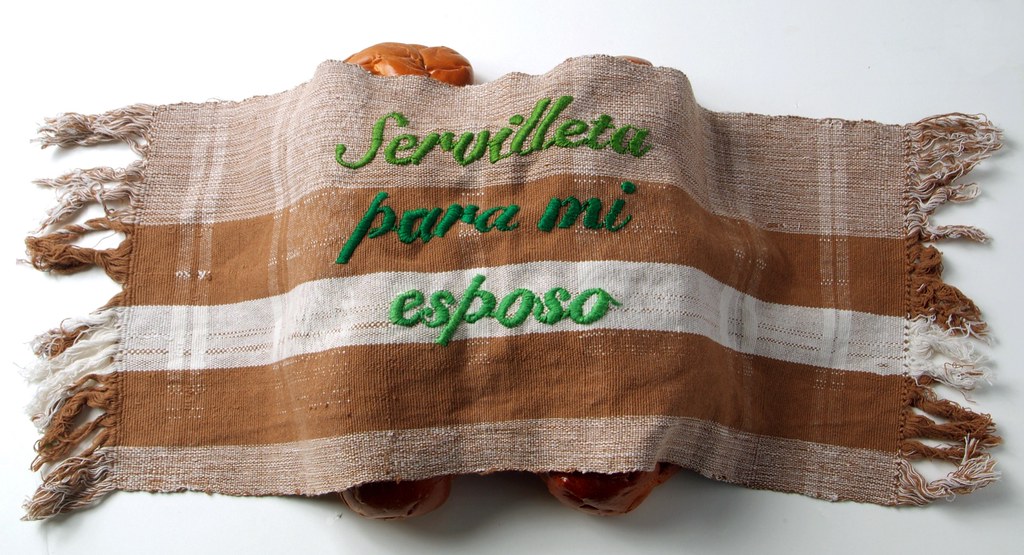 Napkin For My Husband, 2007Napkin has been given an additional function, as a challah cover. One covers the challah, or bread made specifically to honor the Sabbath, before the blessing is said and the bread is cut. To embellish a cover heightens the ritual by making the objects beautiful. Napkin tethers together Jewish practice and the work of a relationship. Through her demonstrated knowledge of Jewish custom in her work, one wonders if she also knows Eishet Hayil, a song sung in praise of one’s wife. “A good wife, who can find? She is precious far beyond rubies.” Perhaps Escobar is not so passive aggressively demanding to be serenaded.
Napkin For My Husband, 2007Napkin has been given an additional function, as a challah cover. One covers the challah, or bread made specifically to honor the Sabbath, before the blessing is said and the bread is cut. To embellish a cover heightens the ritual by making the objects beautiful. Napkin tethers together Jewish practice and the work of a relationship. Through her demonstrated knowledge of Jewish custom in her work, one wonders if she also knows Eishet Hayil, a song sung in praise of one’s wife. “A good wife, who can find? She is precious far beyond rubies.” Perhaps Escobar is not so passive aggressively demanding to be serenaded.
Jesus Makes a Short Lived Appearance in Portugal’s Playboy
 read more on Guanabee
read more on Guanabee
Latina Role Model on Tiki Tiki
Latina Role Model is on Tiki Tiki: Stories with Cultura, Color and Sabor, thanks to post by Carrie Ferguson Weir entitled Smart Latina vs Sexy Latina. Check out the post and be sure to leave your responses!
Becoming Mainstream?
Darja Bajagić
Darja sent me a beautiful email on YouTube earlier this week. Needless to say, I was quite taken by her.
[youtube=http://www.youtube.com/watch?v=SuZtuDZjvQE][youtube=http://www.youtube.com/watch?v=6hY2_e-HWYI][vimeo=http://vimeo.com/3465404][vimeo=http://vimeo.com/3064268]
SHOMER NEGIAH PANTIES ON ESTY
Shomer Negiah Panties have finally arrived!! Get a them on ShomerNegiahPanties.com and Etsy Shomer Negiah is a concept in Jewish law halacha that prohibits any degree of physical contact with, or touching of, a member of the opposite sex, except for one’s spouse and immediate family. Shomer means “guards”, but due to its common use in phrases relating to religious practice, it has come to mean: “adhere to” as well. Negiah is the Hebrew word for “touch”, and thus Shomer Negiah is a term used to describe one who “guards the touch” or simply “adheres to restrictions of touch”. Although the feminine form of the term is technically Shomeret Negiah, it is almost always used in the masculine, even when in reference to women. Shomer Negiah Panties allow a woman to abide by the halacha, but still be individual and sexy at the same time.
Shomer Negiah is a concept in Jewish law halacha that prohibits any degree of physical contact with, or touching of, a member of the opposite sex, except for one’s spouse and immediate family. Shomer means “guards”, but due to its common use in phrases relating to religious practice, it has come to mean: “adhere to” as well. Negiah is the Hebrew word for “touch”, and thus Shomer Negiah is a term used to describe one who “guards the touch” or simply “adheres to restrictions of touch”. Although the feminine form of the term is technically Shomeret Negiah, it is almost always used in the masculine, even when in reference to women. Shomer Negiah Panties allow a woman to abide by the halacha, but still be individual and sexy at the same time.
video reel
[youtube=http://www.youtube.com/watch?v=3li_mT--f-A&hl=en]
Beverly A. Normand and the Rald Institute
Rald Institute's mission is to assist at risk children and individuals with learning, social-emotional, and other disabilities. We strive to enhance self-worth while strengthening cognitive and affective domains. We work to increase public awareness of various disabilities and function as advocates. The institute supports schools by providing technical assistance to staff. Rald provides experiences in the arts because we believe such experiences help children expand critical thinking, increase imagination and develop an appreciation for cultural diversity. Inclusive art workshops are offered at no cost to children. The institute is run by volunteers and there are no charges for services to individuals.
here is a link to an abc special on Beverly's work.
Beverly Normand, Ph.D., Founder and President, is a consultant for public and private schools in Illinois, and is lecturer and adjunct professor for several universities. She recently retired from the Office of Specialized Services, Chicago Public Schools, after thirty-four years of service as Special Education Teacher, Citywide Instructional Specialist, and Facilitator for School Based Problem Solving/Response to Intervention programs in Psychology and Special Education. She earned degrees from Roosevelt University, DePaul University and Chicago State University. She was a contributing writer for several publications of Chicago Public Schools, is the recipient of numerous educational awards, special recognitions, and various grants. She has written and hosted several educational television programs, has been published in numerous journals and magazines and has participated in various research projects.
A poet, designer, lyricist and patron of the arts, she has collaborated with artists and musicians on special projects and has planned and coordinated cultural programs and art exhibitions for school children, churches and other institutions throughout her adult life.
Serving as Commissioner of Religion and Race for the United Methodist Church in the South Shore Community of Chicago for twenty years, Normand developed activities and programs to support African American history and culture, while also planning activities and programs to strengthen multi-cultural exchange and diversity training. She served as editor for the Nimbus publication for many years.
Normand has helped thousands of pupils, parents, teachers, ancillary teams and school administrators, and is highly respected for her integrity, creativity and skills. "I believe in interdisciplinary instruction and all curricula that stimulate the imagination and lead us away from mediocrity and complacency. The mission of Rald Institute is to reduce the at-risk population, support children and individuals with special needs in a manner which leads to self-actualization, support as many parents and teachers as we can, and help twenty-first century educational leaders maintain integrity and democratic forms of leadership, while problem solving."
ARTE ≠ VIDA: ACTIONS BY ARTISTS OF THE AMERICAS
Last weekend Carianne and I went to NY for the 2008 Whitney Biennial. As we expected from a survey of Contemporary American Art, not everything in the exhibition appealed to us. However neither of us was disappointed because we were not expecting to be unilaterally wowed. Upon leaving the Whitney, we got into an in-depth discussion about individuals' preconceived expectations, and the role they play in the determining interaction/interpretation/enjoyment, with actual works of art. Soon after this conversation, I was put to the test. As any young MFA student (traveling to New York) who has any hopes of some day having a career, Carianne and I were preparing to leave our hotel, to visit the elusive Chelsea Galleries, when I came upon an announcement for a show at El Museo Del Barrio, ARTE ≠ VIDA: ACTIONS BY ARTISTS OF THE AMERICAS
“Arte no es vida” surveys, for the first time ever, the vast array of performative actions created over the last half century by Latino artists in the United States and by artists working in Puerto Rico, the Dominican Republic, Cuba, Mexico, Central and South America.
Many of the works included in Arte ≠ Vida have subtle or overt political contexts and content: military dictatorships, civil wars, disappearances, invasions, brutality, censorship, civil rights struggles, immigration issues, discrimination, and economic woes have troubled the artists’ homelands continuously over the past four decades and therefore have infiltrated their consciousness. According to curator Deborah Cullen, “the exhibition title challenges the commonplace idea that art is equivalent to life, and life is art. What is proposed through these many works is that while art affirms and celebrates life with a regenerative force, and sharpens and provokes our critical senses, artistic actions which address inequalities and conflict are not equivalent to real life endured under actual repression.”
Over 75 artists and collectives are represented in Arte ≠ Vida, including ASCO, Tania Bruguera, CADA, Lygia Clark, Papo Colo, Juan Downey, Rafael Ferrer, Guillermo Gómez-Peña, Alberto Greco, Alfredo Jaar, Tony Labat, Ana Mendieta, Marta Minujin, Raphael Montañez-Ortiz, Hélio Oiticica, Tunga and contemporary practitioners including Francis Alÿs, Coco Fusco, Regina José Galindo, Teresa Margolles and Santiago Sierra. The exhibition is arranged in four major sections, in which each decade is represented by several specific themes that often cross national boundaries. 1960-1970 looks at select precursors, signaling, destructivism and neoconcretismo; 1970-1980 considers political protest, class struggle, happenings, land/body relationships and border crossing; 1980-1990 focuses upon anti-dictatorship protest and dreamscapes; and 1990-2000 references the Quincentenary, multiculturalism, postmodernism and endurance. An additional section highlights interventions that artists have carried out on television over the past 20 years. In these chronological, thematic groupings, viewers will be able to explore the interconnections among various artists’ actions as well as the surges of activities triggered by specific events in certain countries.
I didn't know what to do. This sounded to good to be true, but we also knew we were supposed to visit the Chelsea Galleries. I considered just buying the catalogue to the exhibition and skipping the show. I don't know if it was faith or instinct that got us there, but I can say with out any doubt in my mind that this was single handedly the best exhibition I have ever attended.
"¿Quién puede olvidar las huellas?," Regina Galindo. 2003.
Galindo walking through the streets of downtown Guatemala City, wetting her feet in a blood-filled bucket, and leaving a path of footprints from the Constitutional Court building to the Presidential Palace, where she was welcomed by a police battalion. The Court had just validated former dictator Efraín Ríos Montt, the country’s foremost author of genocide, as a presidential candidate.
[youtube="http://uk.youtube.com/watch?v=D46p71QdCTc"]

Oscar Bony (1941-2002) hired a working-class family at twice their going wage to pose in a Buenos Aires gallery as a living work of art
[youtube=http://uk.youtube.com/watch?v=8N5xbLtokZY]
"Arte Reembolso/Art Rebate" by Elizabeth Sisco, Louis Hock and David Avalos. 1993.


[...] "The current economic recession has been debilitating for many artists regardless of the content of their work. Since this climate is characterized by a particular hostility toward controversial art, it is especially significant that Elizabeth Sisco. Louis Hock. and David Avalos have maintained a reputation for causing trouble in San Diego. Their collaborative public art projects receive scandalous reports in local and national news media and are often used as examples of the National Endowment for the Art' inadequate standards of quality. Their most current collaborative project Art Rebate (1993) refunded $10 bills to 450 undocumented workers along the San Diego, California/Mexico border. It was commissioned by the Museum of Contemporary Art, San Diego and Centro Cultural de la Raza as part of the "La Frontera/The Border" exhibition. In response to recent attention to border relations due to NAFTA and other government policies, the artists wished to refute the popular misconception that undocumented Mexican workers do not pay taxes as well as demonstrate. albeit with a small symbolic gesture, their appreciation of the undocumented as valued members of Western states, communities. Furthermore, I believe their work has significant implications for undocumented workers from other nations, residing in other regions of the United States - Caribbean workers in Florida and New York City, for example. If the communities in which the undocumented workers from these areas work and reside could also acknowledge their common contributions, in the form of taxes among other things, then perhaps we as a society could also begin to address the crimes inflicted upon these groups and apply our democratic notions of human rights to those within our national borders. [...]
"The projects are clearly controversial. That's not an accident. It's not as if someone latches onto the projects and holds them up as problematic. We intend to create something that is provocative and engenders a public discussion. It is public art, not art in the public. The work is defined by its performance in the community. The public discussion is crucial to the project. In order to begin a discussion we initiate an action - for example, a bus poster or a $10 rebate - that starts the ball rolling. We definitely aim to draw in the broadest spectrum of people, including those in power for the discussion. Obviously the media is not a neutral mechanism for communicating the events that unfold during the projects: it has an agenda that shapes its participation in the discussion. For example, much of the language used to describe Art Rebate in the press was the same inflammatory rhetoric promoted and laid out by the politicians who had given a profile of blame to the undocumented. Similarly, the press had a hard time imagining, and therefore was unable to fairly convey, the undocumented as taxpayers. The press was invited to experience the act of rebating these signed $10 bills. They were encouraged to ask the opinion of undocumented workers concerning their status as taxpayers, but the responses failed to appear prominently in the news media. The media coverage was not a means of evaluating the project but rather a component of the project. Their viewpoints describe a conceptual social space in which they situate the taxpayer and the undocumented in different realms."
"The Parthenon of Books/Homage to Democracy, Buenos Aires," Marta Minujín. 1983.
In December 1983 the Argentine Conceptual artist Marta Minujin and a group of helpers spent 17 days building a full-scale model of the Parthenon in a public park in Buenos Aires, Roberta Smith writes. Except for a metal scaffolding, it was made almost entirely of books wrapped in plastic. All the books had been banned by one of the most oppressive juntas in the country’s history, which was just being dismantled after Argentina’s first democratic election in a decade. “The Parthenon of Books/Homage to Democracy,” as Ms. Minujin’s work was titled, stood for about three weeks. Then the public was allowed to disassemble the piece and keep the books.
partenon de libros marta minujinAvenida 9 deJulio y Avenida Santa Fe. Buenos Aires. Argentina. Concebida como un monumento a la democracia y a la educación por el arte, Partenón constaba una estructura metálica, réplica del partenón, recubierta con prohibidos durante la dictadura militar.


[...]In a similar fashion to the live human spectacles of the past, Fusco and Gomez-Peña performed the role of cultural "other" for their museum audiences. While on display the artists' "traditional" daily rituals ranged from sewing voodoo dolls, to lifting weights to watching television to working on laptop computers. During feeding time museum guards passed bananas to the artists and when the couple needed to use the bathroom they were escorted from their cage on leashes. For a small donation, Fusco could be persuaded to dance (to rap music) or both performers would pose for Polaroids. Signs assured the visitors that the Guatinauis "were a jovial and playful race, with a genuine affection for the debris of Western industrialized popular culture . . . Both of the Guatinauis are quite affectionate in the cage, seemingly uninhibited in their physical and sexual habits despite the presence of an audience." Two museum guards from local institutions stood by the cage and supplied the inquisitive visitor with additional (equally fictitious) information about the couple. An encyclopedic-looking map of the Gulf of Mexico, for instance, showed the supposed geographic location of their island. Using maps, guides, and the ambiguous museum jargon, Fusco and Gomez-Peña employed the common vocabulary of the museum world to stage their own display[...]
"Construction of a Traditional Rural Oven,'' Víctor Grippo y Jorge Gamarra. 1972.
CONSTRUCCION DE UN HORNO POPULAR PARA HACER PAN
Intención: Trasladar un objeto conocido en un determinado entorno y por determinada gente, a otro entorno transitado por otro tipo de personas.Objeto: Revalorizar un elemento de uso cotidiano, lo que implica, además del aspecto constructivo escultórico, una actitud.Acción:a) Construcción del Hornob) Fabricación del Panc) Partición del Pan.Resultante pedagógica: Describir el proceso de construcción del Horno y de la fabricación del Pan. Distribuir una hoja. Será posible la participación del público mediante un intercambio de información.
"Untitled (Body Tracks),'' Ana Mendieta. 1974.

Guest Post by Debbie Wolen: Ta'anit Esther and Mardge Cohen
Guest Post by Debbie Wolen*: Ta'anit Esther and Mardge CohenI had never heard of the holiday [Ta'anit Esther] until one year ago, when Rabbi Brant said that the JRF and the RRC wanted to honor Dr. Mardge Cohen for Ta'anit Esther. Mardge asked me what Ta'anit Esther was. I had never heard of it, and I have been Jewish all my life.Isaac Saposnik is working on the Philadelphia side of this RRC/Kolot "reconstruction" of Ta'anit Esther as a Jewish Day of Justice. Ta'anit Esther is described in the Book of Esther (which I did actually read for the first time, in preparation for organizing this event. It describes Esther's initial reluctance to get involved with advocating for her people. When Mordicai first told Esther about the plot, she was afraid to intervene. Apparently, her conscience and sense of justice/solidarity/responsibility was stronger than her fear, and gave her the energy and courage to intervene. Her struggle is interesting and a process that I know I face often in my life, so I can really identify with Esther's struggle. Prior to her intervention, Esther fasted, and asked the whole Jewish community to fast with her in solidarity. Thus, the Fast of Esther is one of several Jewish fast days. (It lasts from sunrise to sundown on March 20. That is why we are having East African (Ethiopian) hors d'ouerves at the March 19 observance.)I bought an Art Scroll prayer book recently, so I looked, and sure enough, Ta'anit Esther is listed as a fast day. It is not described as a Jewish day of justice, however. This is the new reconstruction of it. I also mentioned it to an Israeli fellow, and he said, "Oh, yes, sure, Ta'anit Esther, of course." But, I have asked other people who are much more knowledgeable and involved Jewish people than I, and they had not heard of Ta'anit Esther previously.When I read the Book of Esther, I was somewhat concerned about the justice described there and the assumptions I made about what the reconstructionists meant by "Jewish day for justice." The justice in Esther is revengeful and quite bloody! I asked Isaac about this. He said this Jewish Day for Justice implies social justice, the type of justice that Mardge Cohen and others in Rwanda are working for, making the lives of the survivors of the 1994 genocide better, making the lives of the poor and powerless more empowered. Well, it was obvious, but the bloody revenge in Esther is called justice, too.Mardge Cohen, MD, is a woman who has struggled with social injustice during her whole medical career. She is really a remarkable woman, and her work is on the level of Paul Farmer, in my opinion. I saw some slides she showed at our workplace in 8/2000, of her tour of HIV projects in South Africa after the 2000 International AIDS conference. I was inspired by her slides so that I started trying to educate folks at JRC about AIDS in Africa, and to raise funds for HIV projects there. I am just one of many she has inspired by her example.Here is a jewish text study by Jordan Appel Ta’anit Esther text studyThanks a lot for your interest and supportDebbie Wolen
*About Debbi:
I'm a family nurse practitioner, have worked in HIV primary care at Cook County Hospital for nearly 17 years with people who are medically indigent and suffer the indignities of poverty. I was a public health nurse before that. I have sought inspiration from many sources. My first source of inspiration was my childhood rabbi, Leonard Mervis, who gave sermons on social justice, anti-war and in support of the civil rights movement (like you, my parents insisted on my attendance through high school, every single Friday evening! So, rather than be bored, I listened to the interesting sermons.) I am a product of Cicero, Illinois. My cousins marched against Martin Luther King when I was 15. That was a radicalizing experience that affects me even today, in my middle age. Also, your mother [Tina Escobar] was the only teacher I could really relate to in my two years at Rush College of Nursing, and she only taught our class for 2 weeks!
The Cuentos Foundation
I just submitted the work of Michele Feder-Nadoff, to the magazine I work for Zeek. Michele is a dear friend and a phenomenal artist, activist and educator. I thought it would be a good idea to share some information about Michele and to promote her organization the cuentos foundation. Artistic Director, Michele Feder-Nadoff, who is Jewish, founded Cuentos in 1998 with the humanist vision and commitment to tikkun haolam, a Jewish principal expressing each person’s responsibility to play a part in "healing the world." Cuentos members believe art is a transformative catalyst for effecting positive social change. Our work combats prejudice and discrimination through artistic and educational intergenerational projects and programs promoting mutual understanding.The abundance of cultural wealth living doorstep to doorstep in our neighborhoods provide all of us an opportunity to engage with and learn about each others' backgrounds. What connects us and how can live in peace together, connected by mutual understanding and appreciation of different cultures from around the globe?
Artistic Director, Michele Feder-Nadoff, who is Jewish, founded Cuentos in 1998 with the humanist vision and commitment to tikkun haolam, a Jewish principal expressing each person’s responsibility to play a part in "healing the world." Cuentos members believe art is a transformative catalyst for effecting positive social change. Our work combats prejudice and discrimination through artistic and educational intergenerational projects and programs promoting mutual understanding.The abundance of cultural wealth living doorstep to doorstep in our neighborhoods provide all of us an opportunity to engage with and learn about each others' backgrounds. What connects us and how can live in peace together, connected by mutual understanding and appreciation of different cultures from around the globe?
|
check out their new book: Ritmo de Fuego
Ritmo del Fuego / Rhythm of Fire is a unique achievement, telling the story of the deep-seated copperworking tradition of Santa Clara del Cobre, an ancient community in the forested mountains of Michoacán, Mexico. What is often seen as “folk art” is shown to stem from early workshops established in Michoacán during the 8th-9th centuries AD, by coastal traders and artisans from the Andean Region of South America. Since then, the manufactures have included utilitarian and ornamental objects. Many have been recovered at archaeological sites, most notably from the 15th century Tarascan Kingdom. Others embrace forms of Spanish origin after the 16th century conquest. Today in the expanding international market, Santa Clara copperwares include a wide range of sophisticated decorative vases, pitchers, trays, dinner wares and related forms. A vital community has evolved with this ongoing tradition, portrayed with affection and care by the project organizer Michele Feder-Nadoff, and the many other authors in this remarkable, well written contribution to the cultural history of the Americas.
click here to purchase
Obsessed With Frida Kahlo
obsessed with frida kahlo, 2007
[youtube=http://www.youtube.com/watch?v=rxqo7aJtD0U]
el es frida kahlo, 2007
[youtube=http://www.youtube.com/watch?v=xlMPoFXRT18]
part of the piece I did for d[x]i magazine on the commodification of Frida Kahlo
auto retrato, 2003
frida painting, 2007
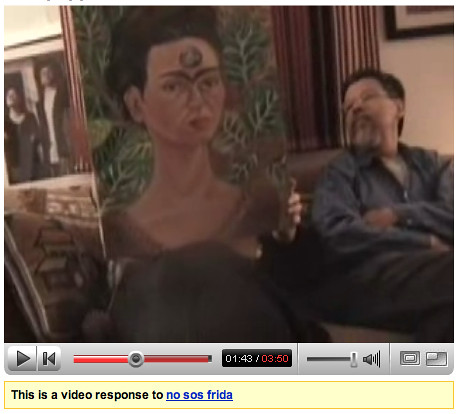
frida puppets, 2007
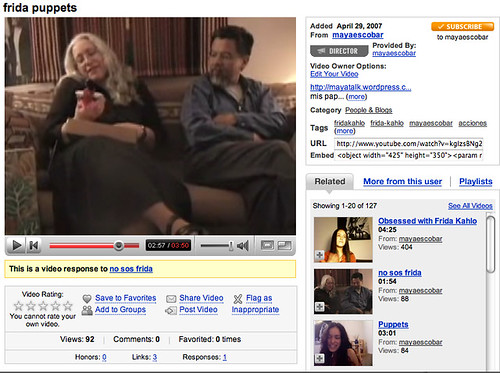
[youtube=http://www.youtube.com/watch?v=QzqBX0HoPSo]
In search of the #1 Frida Kahlo fan in the World

PROVE IT answer the following questions:
When did you fall in love with Frida?
Why do you admire her?
What trivia do you know about Frida Kahlo?
How many and what Frida objects do you own? (prints of her work, t-shirts, mugs, wall hangings, toothbrushes, etc...)





please leave a written comment, submit photos, or a video responseDressed as Frida
Shomer Negiah Panties
SHOMER NEGIAH PANTIES NOW AVAILABLE ON ShomerNegiahPanties.comShomer Negiah is a concept in Jewish law halacha that prohibits any degree of physical contact with, or touching of, a member of the opposite sex, except for one's spouse and immediate family. Shomer means “guards”, but due to its common use in phrases relating to religious practice, it has come to mean: “adhere to” as well. Negiah is the Hebrew word for “touch”, and thus Shomer Negiah is a term used to describe one who “guards the touch” or simply “adheres to restrictions of touch”. Although the feminine form of the term is technically Shomeret Negiah, it is almost always used in the masculine, even when in reference to women. Shomer Negiah Panties allow a woman to abide by the halacha, but still be individual and sexy at the same time. post by dovbear on the panties recieved these comments
post by dovbear on the panties recieved these comments
my pink sexy low cut bras say vlo sasuru in micro print ... lolfrumbabe | Homepage | 02.22.07 - 2:00 pm
why don't you ASK her, DB? Or would that be un-tznius (as opposed to, say, visiting her blog, looking at her panties, and then tattling on your own blog...) :)Tzipporah | Homepage | 02.22.07 - 2:34 pm
this is much more tzanuah.Trust me. I'm a man :)DovBear | 02.22.07 - 2:44 pm
"Shomer Negiah Panties," essentially ordinary cotton undies, I'm going to run over to CafePress and put some "Shomer Negiah Thongs" up for sale.Al Gore | 02.22.07 - 3:07 pm |
What about the fringes? Women unite for equality! We want fringes on our panties!Anonymous | 02.22.07 - 3:13 pm
How about upgrading to a tattoo strategically placed on one's behind? This could be a real trend on the upper west side!Anna Nicole | 02.22.07 - 3:18 pm |
How about upgrading to a tattoo strategically placed on one's behind? This could be a real trend on the upper west side!
Totally unecc. In Willy. they've found the combination of bald heads and really thick stockings serve the same purpose.DovBear | 02.22.07 - 3:27 pm |
that's a weird fetish. :)Tzipporah | Homepage | 02.22.07 - 3:31 pm |
Not a fetish. A form of birth control.Anon | 02.22.07 - 3:39 pm |
I think it's just for giggles. I could imagine SN girls giving each other these panties as a joke... the number of SN guys who'll ever see them on a girl is probably tiny.quietann | 02.22.07 - 4:10 pm |
Granny panties are by definition shomer negiah.--------
Perhaps what the world REALLY needs are burqas with playboy bunnies or 'party-babe' stencilled across the front.The Back of the Hill | Homepage | 02.22.07 - 4:18 pm |
DB:Been done before. Look, don't you think this makes the statement just a bit more...... pointed? http://www.corkscrew-balloon.com...torture/ 31.html
Anon:"A form of birth control"
A form of birth control??? Wow, I'd hate to know what you consider birth-out-of-control, then.Baal Devarim | Homepage | 02.22.07 - 4:33 pm |
that's hot....ThePervert | Homepage | 02.22.07 - 4:52 pm |
I just don't see it.Then why bother giving old Maya and her incredibly unfunny, juvenile and tasteless underwear any more free publicity? What motivates you to post what you do really mystifies.Chaim G. | 02.22.07 - 5:13 pm |
Oooh, these could be useful for the frum girl who secretly moonlights as a stripper. Warning, guys -- all lookie, no touchie.GoldaLeah | 02.22.07 - 5:19 pm |
the frum girl who secretly moonlights as a stripper. A match truly made in hell as her audience would no doubt comprise frum boys who secretly "moonlight" as patrons of "gentlemens" clubsChaim G. | 02.22.07 - 5:28 pm |
Kinda like the "Sanitized for your protection" ribbons on motel toilets.Psycho Toddler | Homepage | 02.22.07 - 5:54 pm |
A match truly made in hell as her audience would no doubt comprise frum boys who secretly "moonlight" as patrons of "gentlemens" clubs...I now have this mental image of bearded young gentlemen wearing ill-fitting 'gentile' clothes yelling "remove your sheitel, remove your sheitel". Thank you. It will take me a while to get over this trauma.The Back of the Hill | Homepage | 02.22.07 - 6:14 pm |
BOTHDain ershtoinung iz gornit antkegen der ershtoinung fun zaira vaiber If only such occurences were as humurous and harmless as the "sleeveless bar" scene that you conjured.Chaim G. | 02.22.07 - 6:20 pm |
I can see them being a present for a friend too--or a joke for one's husband.I don't see them having any halachic purpose, though. Unless there's a mitzvah to wear tacky panties that I somehow missed.balabusta in blue jeans | Homepage | 02.22.07 - 6:27 pm |
I'm married, and I would wear them. I think they're hilarious. But I'd be too scared to give them to anyone I know--they might take it the wrong way.Rivka | 02.22.07 - 8:39 pm |
Pardon me for the overshare, but I have a pair of panties that say "Girls know best" on the front. And there are times that they are appropriate for the situation, like maybe when I need a reminder that girls really do know best :) (I am almost 43, so hardly a girl, but the sentiment is the same.)Similarly, I could see a shomer negiah young woman wearing these panties on a date. Just knowing what her panties say might help her keep her skirt on!quietann | 02.22.07 - 10:21 pm |
at the mall any day now, i'm expecting to see "Shomer Negiah" stenciled on the butt of some babes yoga pants...eliyahu | Homepage | 02.22.07 - 11:15 pm |
I am truly mystified that this post existsreality | 02.23.07 - 7:38 am |
It's obviously a gag. What's the big deal? Girls that are really shomer are never going to wear them with any expectation that a guy will see them, and those that aren't will wear them for their ironic humor.nicejewishguy | Homepage | 02.23.07 - 11:15 am |
How about upgrading to a tattoo strategically placed on one's behind?Also know as a "Tramp Stamp."Al Gore | 02.23.07 - 12:26 pm |
It should also say "shomer negiah" in braille in case it's dark in the room when being read.Should also say it in Hebrew or Yiddish, so the message is clear to all chareidim as well.B.T.A. | Homepage | 02.25.07 - 1:54 pm |
Ah, should have looked at her site first. DB, now you're linking to tushies?! What a shonda. I go away for a few weeks...In any event, perhaps she could tatoo it on the small of her back, then could wear any panties she likes? Just a thought.B.T.A. | Homepage | 02.25.07 - 1:55 pm |








